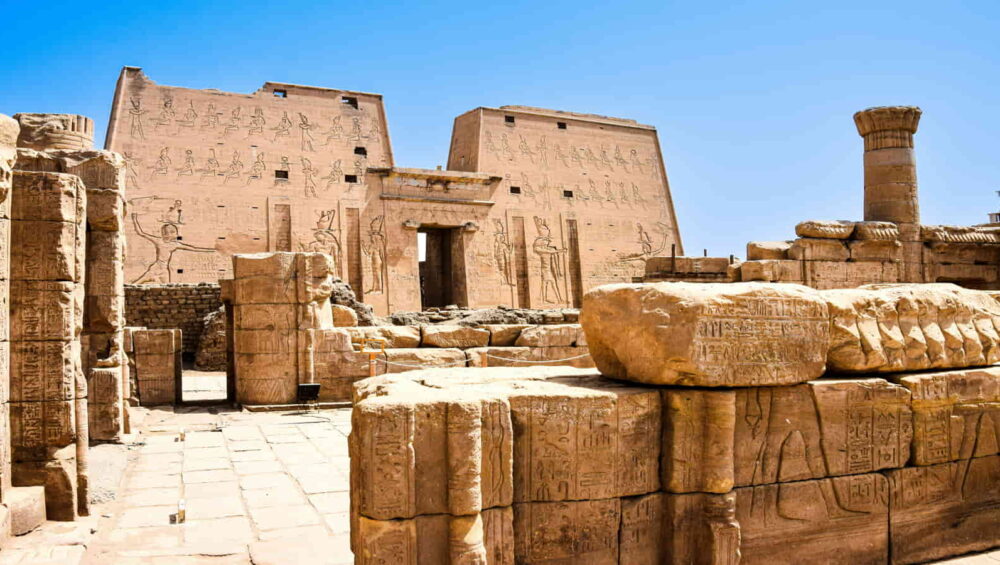The Edfu Temple, dedicated to the falcon-headed god Horus, is one of the best-preserved ancient temples in Egypt. Situated on the west bank of the Nile River between Luxor and Aswan, this awe-inspiring structure offers visitors a glimpse into the spiritual and architectural prowess of the Ptolemaic era. A visit to Edfu Temple is a journey through history, where towering columns, intricate carvings, and mythical stories come alive.
This guide will take you through the fascinating history, architectural marvels, and must-know travel tips for exploring Edfu Temple. Whether you’re a history buff, a casual traveler, or an avid photographer, this article has everything you need to plan your visit.
Sail into adventure with our seamless and inspiring Nile River cruise.
Why Edfu Temple Should Be on Your Itinerary
Edfu Temple is not just an archaeological site; it’s a testament to the enduring legacy of Ancient Egypt. The temple’s remarkable state of preservation makes it a must-visit for anyone exploring Egypt.
Highlights of Visiting Edfu Temple:
- Best-Preserved Temple: Witness a near-intact structure with stunning inscriptions and artwork.
- Mythical Significance: Learn about the battle between Horus and Seth, one of ancient Egypt’s most iconic myths.
- Architectural Grandeur: Explore the massive pylons, sacred halls, and beautiful reliefs that define Ptolemaic architecture.
A Brief History of Edfu Temple
The construction of Edfu Temple began in 237 BCE under Ptolemy III and was completed nearly two centuries later in 57 BCE under Ptolemy XII. The temple was built on the foundations of an earlier structure and served as a major religious center in ancient Egypt.
Key Historical Facts:
- Dedicated to Horus: The temple celebrates Horus’ victory over Seth, symbolizing the triumph of good over evil.
- Ptolemaic Influence: The Greek rulers of Egypt adopted traditional Egyptian styles and motifs, blending cultures seamlessly.
- Rediscovery: The temple was buried under sand and debris until it was excavated in the 19th century, revealing its pristine condition.
Exploring Edfu Temple: Key Features and Attractions
1. The Great Pylon
The temple’s imposing entrance is marked by two massive pylons adorned with intricate carvings depicting scenes of pharaohs making offerings to Horus. This grand gateway sets the tone for the wonders that lie within.
2. The Courtyard of Offerings
As you step inside, you’ll find an open courtyard surrounded by columns with floral capitals. This area was used for public ceremonies and offerings to the gods.
3. The Hypostyle Hall
The hypostyle hall features twelve towering columns and intricately carved walls illustrating religious rituals and myths. The craftsmanship here is truly mesmerizing.
4. The Sanctuary of Horus
The heart of the temple is the sanctuary, where the sacred statue of Horus was housed. Don’t miss the black granite shrine, a masterpiece of ancient art.
5. The Festival Hall
This hall celebrates the annual re-enactment of Horus’ victory over Seth. The carvings and inscriptions here vividly narrate the story.
Fun Facts About Edfu Temple
- Largest Ptolemaic Temple: Edfu Temple is the largest and most complete temple from the Ptolemaic period.
- Symbolism Everywhere: Every aspect of the temple, from its layout to its carvings, carries deep symbolic meanings related to the Horus myth.
- Used for Astronomy: The temple’s design aligns with celestial events, showcasing the Egyptians’ advanced knowledge of astronomy.
Travel Tips for Visiting Edfu Temple
Best Time to Visit
- Ideal Months: October to April, when the weather is cooler.
- Optimal Hours: Early morning or late afternoon to avoid crowds and capture stunning photos.
How to Get There
- By Nile Cruise: Most visitors arrive via a Nile River cruise, making it a convenient stop between Luxor and Aswan.
- By Road: Taxis and private tours are available for those traveling independently.
What to Bring
- Comfortable walking shoes.
- A hat, sunscreen, and water to combat the heat.
- A camera to capture the temple’s incredible details.
Edfu Temple and the Horus Myth
The temple’s artwork and inscriptions vividly depict the story of Horus and Seth. According to legend, Horus avenged his father Osiris by defeating Seth in a dramatic battle. This myth symbolizes the eternal struggle between good and evil and is central to the temple’s design and purpose.
Why Edfu Temple Is a Photographer’s Dream
The interplay of light and shadow, especially in the early morning or late afternoon, creates stunning visual effects. The temple’s towering pylons, detailed carvings, and vibrant reliefs offer countless opportunities for breathtaking shots.
Final Thoughts
Edfu Temple is not just a monument; it’s a journey into the heart of ancient Egyptian spirituality and culture. Its remarkable preservation and rich symbolism make it a must-visit for anyone exploring the wonders of Egypt. From its towering pylons to its sacred sanctuary, every corner of Edfu Temple offers something extraordinary.
Whether you’re fascinated by ancient myths, intrigued by architectural brilliance, or simply looking for a memorable travel experience, Edfu Temple won’t disappoint. Start planning your trip today and uncover the timeless magic of this Ptolemaic masterpiece.
Ready to explore more of Egypt’s ancient wonders? Check out our exclusive Egypt travel packages and expert guides to make your adventure unforgettable!




